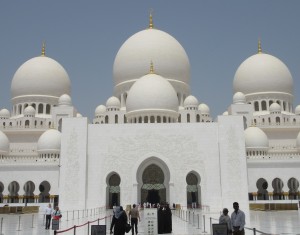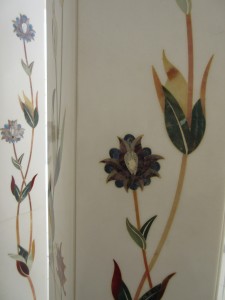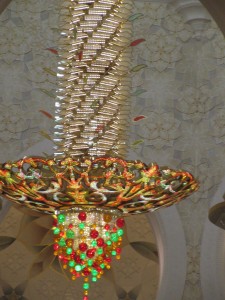“Mad dogs and Englishmen go out in the midday sun…” ~ Noel Coward
As I sit in London, in Holland Park under scattered clouds and mere wisps of blue sky, amidst all the lush flamboyance of summer foliage, it seems unlikely that barely a week ago I was wilting in 47’C in downtown Abu Dhabi.
 There the rabid sun struck the sand with the intensity of strobe lighting, extrovert and forceful, determined to make an impression on innocent eyeballs that cowered behind tinted sunglasses. Here in England the sun is more demure, almost shy, tucking itself modestly behind cotton wool clouds, reticent about shrugging off a slight chill in the air, or making its presence felt with too much enthusiasm. Am I really on the same planet?
There the rabid sun struck the sand with the intensity of strobe lighting, extrovert and forceful, determined to make an impression on innocent eyeballs that cowered behind tinted sunglasses. Here in England the sun is more demure, almost shy, tucking itself modestly behind cotton wool clouds, reticent about shrugging off a slight chill in the air, or making its presence felt with too much enthusiasm. Am I really on the same planet?
Last week I was barrelling down broad boulevards with an old friend in a shiny new car, past stately high rise office blocks, the sunlight reflected ostentatiously in acres of glass or glittering prettily off the sea, as we followed the beckoning minarets to the Sheikh Zayed Grand Mosque. The tour started at 11am, the thermometer was rising by the minute, and there was no shade anywhere.
Ahead of us we could see this enormous marble structure glowing white as a beacon on the skyline, but the roads ducked and wove like knotted wool, one entrance wass blocked by road works, and the GPS was proving fractious in the heat. Eventually, like those childhood mazes, we found our way to the visitors carpark, and sat for one last, self-indulgent minute in the icy air-conditioning, gazing with awe upon the breath-taking splendour of the largest mosque in the United Arab Emirates.
As we bravely ventured into the extreme heat of the day, we wrapped ourselves in cardigans and scarves, to avoid censure from the security guards. Abayahs were available for hire, but we had luckily remembered our own, lighter fabrics. Nonetheless, I had to scrabble to keep my headscarf in place, wishing fervently that I had thought to bring an elastic, as my hair fought to stay under the confines of a light wool wrap. Eventually my friend swaddled my head as best she could and pinned the scarf in place with my sunglasses. I walked tentatively, partly in fear of the scarf unravelling and falling to the floor, partly in fear of breaking a sweat.
Conceived by the late president of the United Arab Emirates, His Highness Sheikh Zayed bin Sultan Al Nahyan, the  mosque named in his honour also contains his tomb, as he died in 2004, three years before the completion of his masterpiece. Construction began in 1996 and would not finish until 2007, nonetheless a monumental achievement for such a vast complex that covers an area of thirty-odd acres and can accommodate up to 40,000 people.
mosque named in his honour also contains his tomb, as he died in 2004, three years before the completion of his masterpiece. Construction began in 1996 and would not finish until 2007, nonetheless a monumental achievement for such a vast complex that covers an area of thirty-odd acres and can accommodate up to 40,000 people.
Apparently Sheikh Zayed’s dream was to establish a structure that would combine the cultural diversity of the Islamic world with the best of historical and modern art and architecture, and his mosque is the realization of that dream: a fusion of Arab, Persian, Mughal and Moorish architecture. The domes, milky, Rubenesque, flawless are inspired by the Mughal architecture of the Taj Mahal, the keyhole archways are Moorish, the slim and graceful minarets pointing to the moon are Arabic.
The architects have borrowed some of the world’s best architectural designs and imported some of the world’s best products to create this ethereal mosque and monument to Islam.
Wandering through the airy colonnades, we admired the sleek pillars inlaid with semi- precious jewels such as mother-of-pearl, agate, lapis lazuli, jasper and amethyst, cut into simple but exquisite designs of long-stemmed, individual flowers. Gilded date palms blossomed at the top of the pillars, and were reflected in the pools around the perimeter.
We walked towards Sheikh Zayed’s tomb, where we could hear the prayers that continue to be said for his soul, eleven years after his death, twenty four hours a day. The memory of Sheikh Zayed is obviously still much loved in the UAE. Headshots have been mounted on huge billboards all over the city and it seems as if every building and street is named after him.
This brilliant and liberal Muslim prince, raised amongst Bedouin tribesmen, was responsible for forming the United  Arab Emirates in 1971 from the seven Trucial States, a collection of sheikhdoms on Persian Gulf. He then stood as its first President for 33 years, until his death at the age of eighty four. With the new country sitting on huge oil reserves, Sheikh Zayid had enormous wealth at his disposable with which to raise the cities of the UAE out of desert sands. He also used the country’s enormous oil revenues to build hospitals, schools and universities and, of course, this sumptuous mosque, the third largest mosque in the world, only belittled by Mecca, and Madina in Saudi Arabia.
Arab Emirates in 1971 from the seven Trucial States, a collection of sheikhdoms on Persian Gulf. He then stood as its first President for 33 years, until his death at the age of eighty four. With the new country sitting on huge oil reserves, Sheikh Zayid had enormous wealth at his disposable with which to raise the cities of the UAE out of desert sands. He also used the country’s enormous oil revenues to build hospitals, schools and universities and, of course, this sumptuous mosque, the third largest mosque in the world, only belittled by Mecca, and Madina in Saudi Arabia.
Crossing the vast marble square, we shed our shoes obediently in front of the mile high doors to the mosque. Revered as a symbol of purity and piety by the Sheikh, much of this mountain of white marble was sourced from Italy and Greece. Somehow the white marble remained cool underfoot, despite the molten sun beating down on it – but beware the darker marble flowers which can burn through the soles of your feet. these had us leaping awkwardly from foot to foot, as if on hot coals.
Inside, the air was cool, and we all breathed out audibly with relief. Wandering through the foyer into the main prayer hall, our eyes were drawn upwards to the concave roof beneath the largest of 82 domes. There swung a gobsmackingly grandiose chandelier made in Germany from Swarovski crystal, plated gold and garish Venetian glass from Murano, particularly surprising amongt the subtle and elegant simplicity of the rest of the architecture and artistry that embellishes this imposing, rather patrician structure.
The main hall can accommodate over 7,000 worshippers, while two smaller prayer halls accommodate 1,500 women and 1,500 elderly respectively. Literally acres of carpet (over 60,000 square feet) cover the floor of the main prayer hall. The carpet was designed by Iranian artist Ali Khaliqi and handwoven in Iran by a team of 1200 artisans, who took two years to complete it. The finished piece weighs thirty five tons, and had to be delivered in several pieces, arriving on two airplanes, and accompanied by five hundred workers who travelled with it, to sew it back together.
Our guide explained that once inside the mosque there is no hierarchy beyond ‘first come first serve.’ Thus, whoever arrives early earns himself a  front row position, close to the Imam and the carved sandalwood menbar, or pulpit, inlaid with mother-of-pearl. On the wall behind the menbar, the ninety nine qualities or attributes of God (Allah) are featured on the Qibla or direction wall in traditional Kufic calligraphy.
front row position, close to the Imam and the carved sandalwood menbar, or pulpit, inlaid with mother-of-pearl. On the wall behind the menbar, the ninety nine qualities or attributes of God (Allah) are featured on the Qibla or direction wall in traditional Kufic calligraphy.
Our cultural tour guide was a friendly, cheerful young man, very open and happy to impart general information about Islamic beliefs. He responded particularly patiently to the avid young English schoolboy who questioned him closely about Islam, and Muslim beliefs.
Our guide explained that Ramadan – due to begin the following day – is a time of spiritual reflection, self-improvement, self-denial through fasting, and the opportunity to focus on Allah – which sounded surprisingly similar to the Christian observance of Lent. Our young interrogator promptly asked if they shouldn’t be doing that every day, anyway and completely floored our genial guide, who eventually smiled and agreed, but added that this was a special time in the year to really concentrate on God and goodness.
As we returned back to the dazzling white light of the forecourt, we reflected quietly on everything we had learned. I would definitely go back for another visit, especially as our tour guide proudly provided so many amazing details that it is embarrassing to admit how many I have already forgotten. But next time I will go at twilight, rather than in the middle of the day, at the hottest time of the year. Mad dogs and Englishmen indeed!
